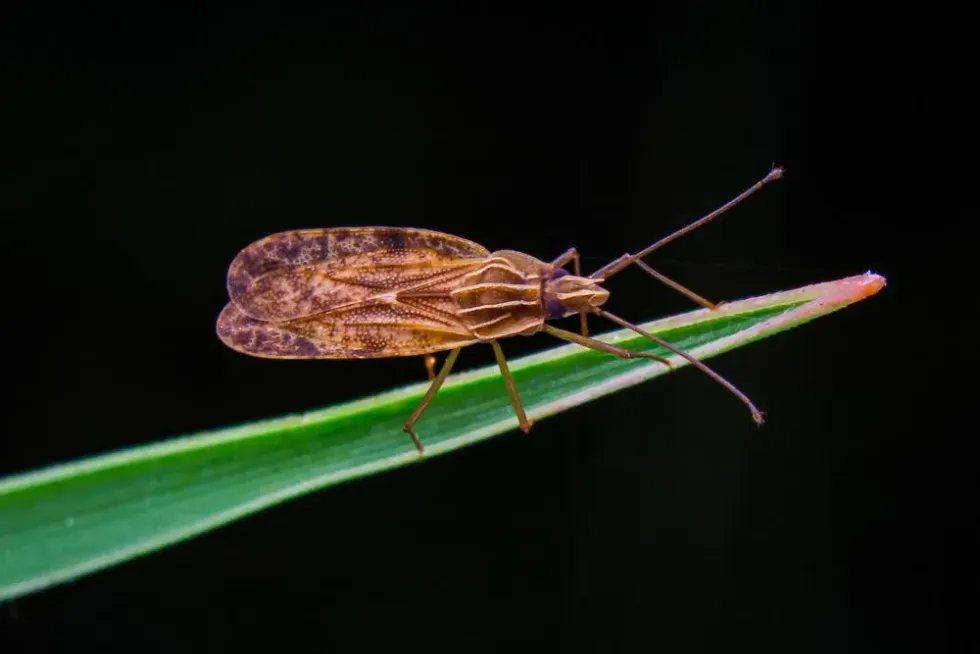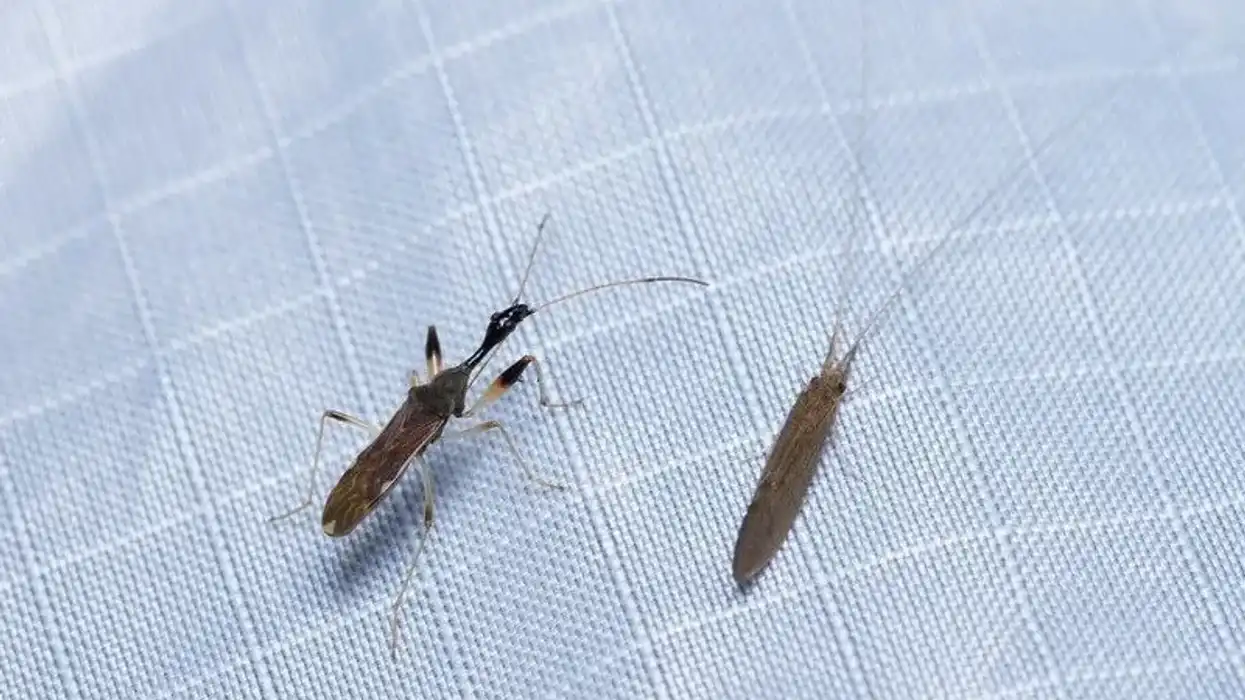The lace bug, from the family Tinigidae and the order Hemiptera, is a teeny tiny insect that lives on the underside of leaves. They get their name from their lace-patterned wings and there are about 140 species of lace bugs in North America.
These bugs are interesting because you can find them in gardens, parks, and woods all over the world. They are so tiny and there are so many of them that it is difficult to track their conservation status, but it is safe to say that the insect is not threatened by extinction.
Why not take a look in your garden or nearby park to see if there are any lace bugs on the undersides of any leaves? You can also learn more about these fascinating crawlies with this article.
Interested in bugs? Why not read our facts about the ambush bug and the green stink bug too?
Lace Bug Interesting Facts
What type of animal is a lace bug?
A lace bug is a kind of insect.
What class of animal does a lace bug belong to?
The lace bug belongs to the Insecta class.
How many lace bugs are there in the world?
There is no information on the global population of lace bugs but it seems likely as there are a lot of them!
Where does a lace bug live?
Lace bugs live in shrubs and trees in woods and in house gardens. They can be found living on host plants, which they feed on.
What is a lace bug's habitat?
The lace bug's habitat is on green leafy plants. Normally, each lace bug completes its whole life cycle on the same host plant and usually, on the same part of the plant.
Who do lace bugs live with?
Lace bugs can be found with other lace bugs and other insects, munching on the same leaf together.
How long does a lace bug live?
A complete lace bug life cycle lasts for 30 - 40 days. First, adult female lace bugs lay eggs on the underside of a leaf. These eggs are partially inserted into the leaf and are almost completely hidden.
Many species of lace bugs secrete a brown substance to harden the eggs and secure them to the leaf. Eventually, dark nymphs emerge from hatched eggs. These dark nymphs go through five to six growth stages before turning into adults.
How do they reproduce?
Lace bugs reproduce sexually. After two adult lace bugs mate, the female lays eggs.
What is their conservation status?
The conservation status of lace bugs is unclear because they have not been evaluated. It is safe to say that lace bugs are not extinct though.
Lace Bug Fun Facts
What do lace bugs look like?
You can't really see what they look like unless you look at them under a microscope. If you were to zoom in, you would see that an adult lace bug has a lace-like pattern on its wings and the surface of its upper body.
This lacy effect is created by tiny, clear cells. Their babies, called lace bug nymphs, are wingless and have dark-colored spines.

* Please note that this is an image of a bug, not a lace bug specifically. If you have an image of a lace bug please let us know at hello@kidadl.com.
How cute are they?
If you are into creepy crawlies, you may find them cute. Their lacy pattern is definitely something that makes them unique.
How do they communicate?
Adult lace bugs may fan their wings to deter predators, and also to communicate with nymphs. Nymphs also respond to an alarm pheromone.
A pheromone is a chemical that animals produce to communicate with other animals or to trigger them to do something. This alarm pheromone signals for the nymphs to flee. The nymphs then gather at a new location, led by an adult lace bug.
How big is a lace bug?
A lace bug is an extremely tiny species. It is under 0.1-0.2 in (0.2-0.5 cm) in length and four times smaller than the width of a human fingertip!
How fast can lace bugs move?
For tiny little creatures, they can move quite quickly. In the first half of May, they are known to be very active and they move between different leaves on the same plant. They can also move very rapidly when they sense danger.
How much does a lace bug weigh?
As lace bugs are so tiny, they feel pretty much weightless to humans.
What are their male and female names of the species?
Males and females are both simply called lace bugs.
What would you call a baby lace bug?
A baby lace bug is called a nymph. Lace bugs have a typical life cycle of an arthropod. They hatch not as lace bug larvae, but as nymphs, which look like adults but without wings and a smaller and more oval body shape.
What do they eat?
Lace bugs love to eat foliage like plants, trees, and shrubs. You can find them feasting on the underside of leaves. They eat the leaf by piercing the epidermis, the skin, and extracting the sap. Once eaten, it leaves the upper surface of leaves scratched and pale yellow.
Are they harmful?
Lace bugs are not harmful to humans. However, they can cause damage to the leaves that they feast on. This damage is not fatal to the plant.
Would they make a good pet?
Lace bugs would not make good pets. Their life cycle is very short and they spend all of their time eating on the underside of leaves.
You may find them in your garden, crawling on your plants, or on the undersides of leaves. You can observe their impact on your plants, and understand more about these creepy crawlies in your garden, but you cannot keep them as pets.
Did you know...
There are many types of lace bugs, including the lantana lace bug, the azalea lace bug, the rhododendron lace bug, the sycamore lace bug, the oak lace bug, and the avocado lace bug.
When nymphs shed their exoskeleton, their cast skins remain attached to the plant foliage. Cast skins are the name for their molted skins.
There are 2000 species of lace bugs, all in the Tingidae family.
Lace bugs have two generations through their growing season. They can also live through the winter.
What does lace bug damage look like?
Lace bugs suck extracts juices from the leaf they are eating, using their needle-like mouths. This leaves white or yellow spots and markings on the surface of the leaf.
If they keep feeding on that leaf, eventually it will leave a hard mottled residue called resin spot on the leaves. Feeding damage occurs in the mid to late summer, when populations of lace bugs are at their highest.
This lace bug damage can lead to leaf discoloration and early leaf drop and once leaf damage has happened, it cannot be reversed. However, there are some preventative measures you can take to take care of your plants.
Lace bugs love to eat specific types of host plants. Their favorites are azalea, rhododendron, cotoneaster, pieris, flowering quince, and and mountain-laurel. Healthy mature trees and shrubs can withstand most damage by these insects. Furthermore, leaf damage varies each year and depends on the lace bug population each year.
Do lace bugs bite humans?
Some people have reported lace bug bites when trying to deal with lace bugs. They claim that they feel a mild bite sensation. This can lead to some irritation but they are not a huge concern to humans.
How to get rid of lace bugs?
There are a few things you can do to protect trees and shrubs in your garden and control levels of lace bug damage. Firstly, you can tolerate them!
Lace bugs do not severely damage plant health so, often, no lace bug treatment is necessary. Normally it is recommended to accept their feeding. Lace bugs have many natural predators and enemies, including assassin bugs, beetles, lacewings, and other insects and larvae.
These insects and enemies act as a natural lace bug control measure and you can grow lots of flowering plants nearby to attract these natural enemies. You can also ensure your plants are healthy as possible by making sure they are properly watered and maintained.
Gardeners can also use high-pressure water spray from a garden hose as a lace bug treatment. These sprays act like heavy rain, knocking nymphs and pests off the foliage. A lace bug nymph does not have wings so cannot go back to the leaves of plants, shrubs, or trees after the spray.
You can also use a natural pesticide or lace bug insecticide on leaves, such as neem oil. It is much better to spray natural and organic pesticides that do not harm other insects, larvae, and critters in your garden as most pesticides are harmful to the environment and to wildlife.
It is best to spray this pesticide in the early spring when eggs hatch on the undersides of leaves.
Some pesticides can be harmful to bees, so it is better to wait until trees and plants have finished flowering. You should carefully read the pesticide label to understand what you are using.
Finally, gardeners are advised to check for lace bugs in spring. You can check plants and leaves in late spring and in summer once or twice a week.
Eliminating the bug during this growing season stops bugs from overwhelming the plant. You can monitor plants that have been infected and have damage and this helps to control the natural damage.
Here at Kidadl, we have carefully created lots of interesting family-friendly animal facts for everyone to discover! Learn more about some other insects including the wheel bug, or the stick bug.
You can even occupy yourself at home by drawing one on our Lace Bug coloring pages.










